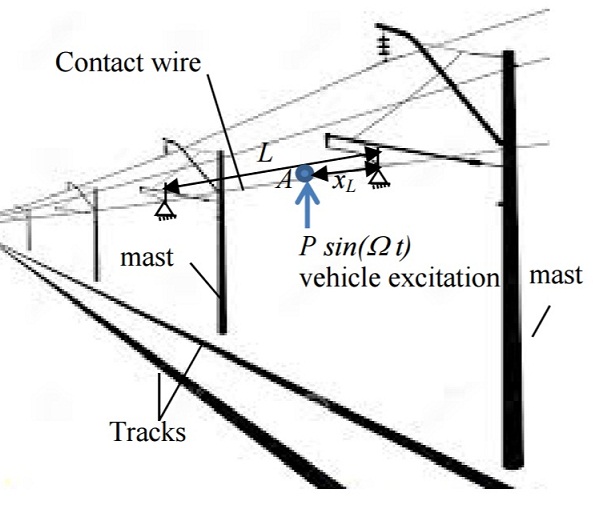Reference no: EM131207073
Topic: Torsional/longitudinal/lateral Vibration of Rods
A Bio-MEMS device consists of a microscaled cantilevered rod that senses a biochemical reaction on the surface of the rod. In particular, the mass of the cantilever changes due to biochemical reaction products sticking to the surface and this in turn is detected via a change in the resonant frequency of the cantilever. The cantilever is made of silicon (Young's modulus, E = 150GPa, poissons ratio v=0.17, density ρ = 2330kg / m3) of diameter d = 5μm and length L=100μm.

a) Determine the first three natural frequencies for axial vibrations in MHz. Draw the corresponding mode shapes.
b) Determine the first three natural frequencies for torsional vibrations as a ratio of the fundamental axial natural frequency of vibration. Draw the corresponding mode shapes.
c) When in use, the Bio-MEMS device is found to pickup a layer of biomass that increases the mass per unit length of the beam by 5%. What % changes in fundamental axial, torsional and lateral frequencies result.
Topic: Transverse Vibration of Strings and Beams
On overhead catenary is used to transmit electrical power through a contact wire to trains as they move along tracks. A section of contact wire of length L and bending stiffness EI is modelled as being pinned between two masts. The tension of the contact wire is tuned so that the transverse string wave travels 4.5 times faster than the maximum speed of the train Vin„, to avoid undesirable standing wave interaction.

a) Determine the first three natural frequencies of transverse string vibration of the contact wire as a function of the length L and Vmax. Ignore the bending stiffness of the wire and assume the contact wire tension is approximately constant throughout it's length.
b) Sketch the first three mode shapes of transverse string vibration.
c) Determine the first three natural frequencies of transverse beam vehicle excitation mast vibration of the contact wire as a function of the length L, mass m, and bending stiffness EL. Ignore the contact wire tension and model the boundary conditions as pinned.
d) Sketch the first three mode shapes of transverse beam vibration Tracks and explain any similarities or differences with the string modes identified in b).
e) Vehicle vibrations excite the contact wire at a moving contact point A as shown at an excitation frequency .0 of 20% of the fundamental beam natural frequency. Assuming transverse beam vibration, approximate the largest amplitude vibration deflection of the contact wire and the fractional position xi/L at which it occurs.
f) Explain if and how your answer in e) may vary if the excitation frequency Ω is 400% of the fundamental beam natural frequency.
g) Identify the conditions under which transverse string vibration assumptions are more appropriate as compared to transverse beam vibration assumptions.
Topic: Approximate Techniques - Rayleigh/DunkerleyMethods
For the overhead catenary problem in problem 2
a) The vehicle connection at A acts as an inertial mass and lowers the fundamental transverse natural frequency by a maximum of 20%, at an unknown position. Assuming beam behaviour, identify the position of the inertial mass where the maximum reduction occurs. Hence estimate the ratio of the inertial mass to the wire mass using Dunkerley's approximate method.
b) Repeat your estimate in a) using Rayleigh's method assuming an appropriate mode shape.
c) Hence determine the best estimate for the ratio of the inertial mass to the wire mass. Explain what effect the inertial mass has on all the other modes.
|
Estimate degree of polymerization of with an average weight
: Estimate the degree of polymerization of with an average molecular weight of 150,000 the molecular weight of an ethylene monomer is 28. To enhance processability of a polymer why would you want to decrease its molecular weight?
|
|
Calculate the total power dissipated in the op-amp circuit
: Calculate the total power dissipated in the op-amp circuit. What are the currents supplied by V + and V -?
|
|
Prepare the entries to reflect the issuance of the units
: On September 1, Jordan Corp., issued 10,000 “units”. Each unit sold for $150. Each unit gave its owner rights to 5 shares of common stock and 1 share of a new type of preferred stock. Prepare the entries to reflect the issuance of the Units on Septem..
|
|
How strategic planning differs from strategic management
: In your own words, define strategic planning and explain why it is crucial to an organization's survival. In your response, include a description of how strategic planning differs from strategic management. Lastly, explain how your current or prev..
|
|
Determine the natural frequencies for torsional vibrations
: Determine the first three natural frequencies for torsional vibrations as a ratio of the fundamental axial natural frequency of vibration. Draw the corresponding mode shapes.
|
|
Estimate the differential input voltage at which breakdown
: For the input stage of the 741 op-amp, assume B-E breakdown voltages of 5 V for the npn devices and 50 V for the pnp devices. Estimate the differential input voltage at which breakdown will occur.
|
|
Sketch sin with the abscissa angle in degrees
: Sketch sin(377t + 60°) with the abscissa - angle in degrees. - angle in radians. - time in seconds.
|
|
How did the fear of losing market share affect
: After reading the article "UPS holiday season fiasco: a failure of strategic planning," describe where the problem was with UPS' and FedEx's strategic planning. How did the fear of losing market share affect their strategic planning? What are po..
|
|
Determine the smallsignal differential-mode voltage gain
: Consider the BJT op-amp circuit in Figure P13.5. The transistor parameters are: β(npn) = 120, β(pnp) = 80, VA = 80 V (all transistors), and base- emitter turn-on voltage = 0.6 V (all transistors).
|